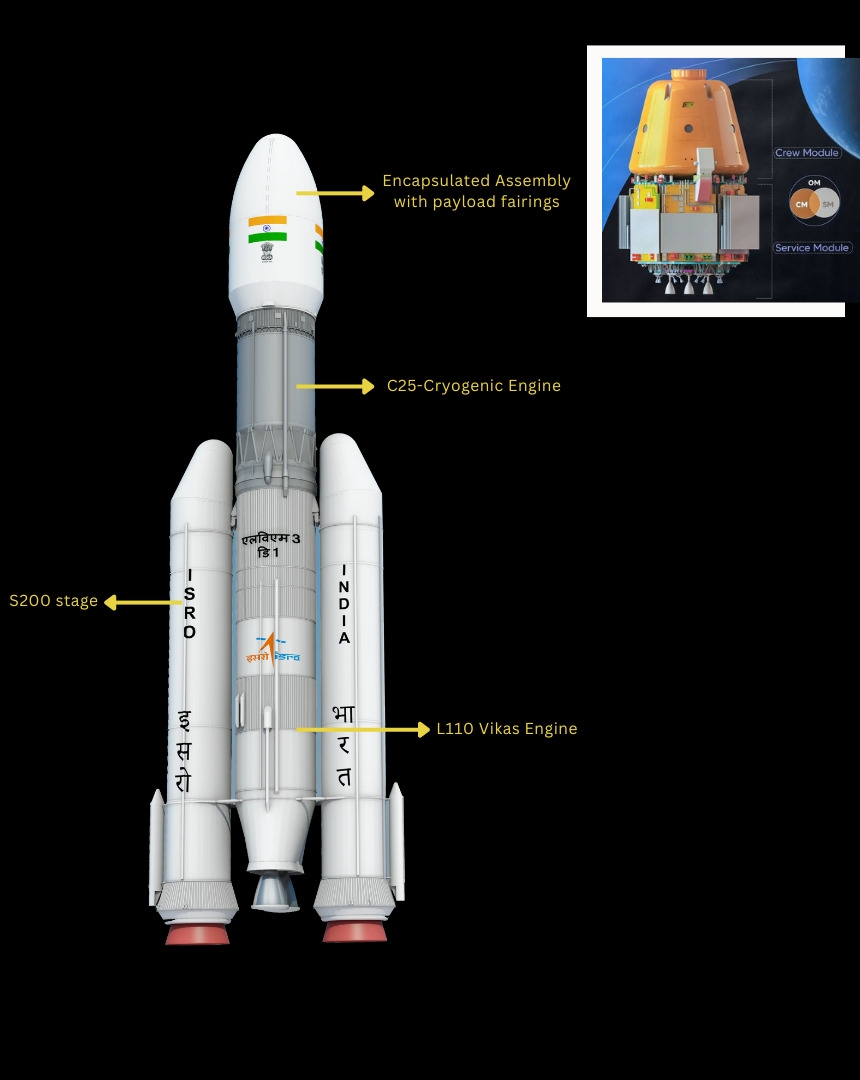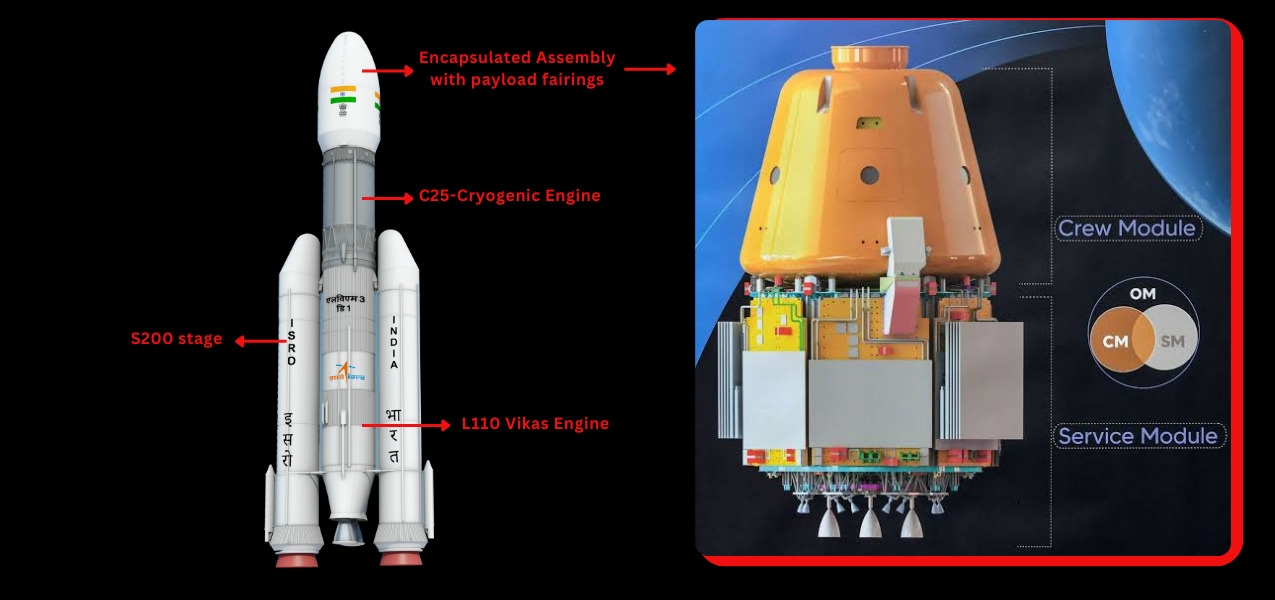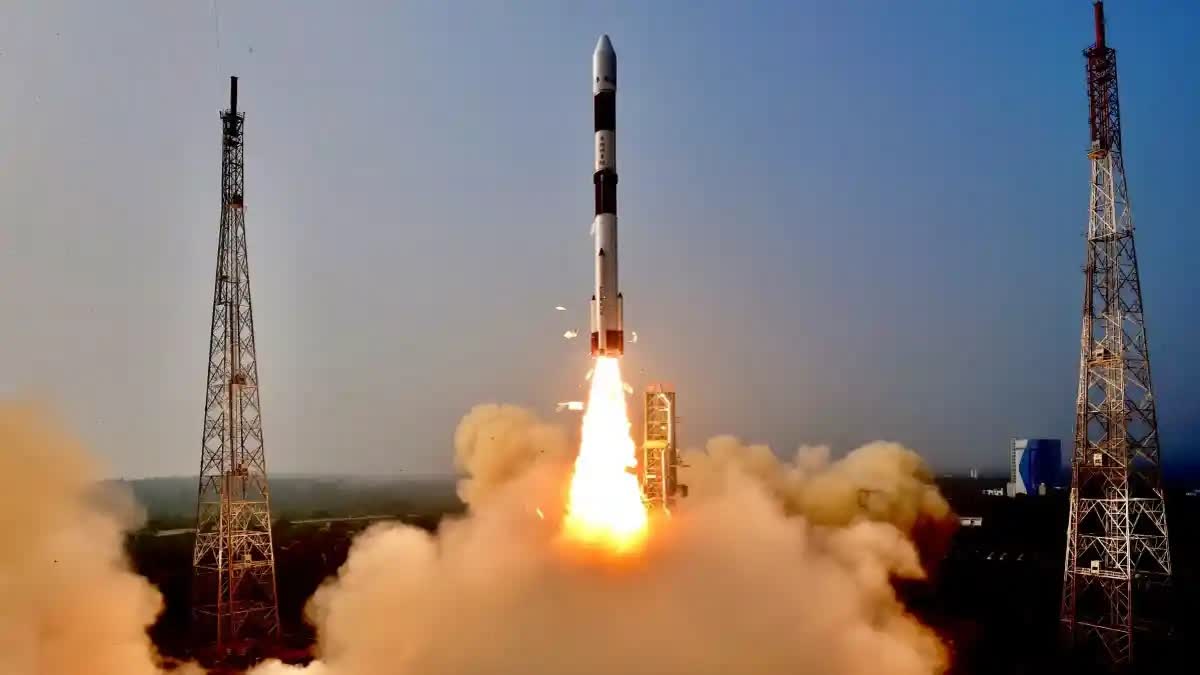Bengaluru: On February 27, 2024, while visiting Kerala, Prime Minister Narendra Modi announced the Indian Air Force pilots chosen for the Gaganyaan mission. Those named were Group Captain Prashanth Nair, Group Captain Ajit Krishnan, Group Captain Angad Pratap, and Wing Commander Shubhanshu Shukla.
The statement was passed at the Vikram Sarabhai Space Centre, where Prime Minister Modi examined the ongoing development of the Gaganyaan mission and labeled the selected crew members with 'astronaut wings'.

Slated for a 2024-25 launch window, the Gaganyaan mission aims to demonstrate India's capacity for manned space travel by propelling a crew into a 400 km orbit for three days, followed by their secure return to Earth, with a splashdown in Indian Sea waters.
The Gaganyaan project, which takes its name from the Sanskrit term for a craft or vehicle that reaches the sky, has been created with an investment of Rs.9000 Crores ($1 billion).
Out of the four astronauts, a final selection of three will be made. These three will travel on ISRO's most powerful rocket, the LVM Mk-3, which has been modified to comply with the criteria for human rating requirements and the name has been rechristened as HLVM-3

Authorities mentioned that the individuals were chosen from a group of Air Force pilots and had been subjected to rigorous physical and psychological evaluations before their selection.
Astronaut Rakesh Sharma, who journeyed to space on Russia's Soyuz spacecraft in 1984, and spent nearly 8 days, is still the sole Indian to have ventured into space.
ISRO is meticulously preparing to safeguard the astronauts' well-being for its First human spaceflight mission, a feat previously accomplished by only three nations—formerly the Soviet Union (Russia), the United States, and China. Should India be successful, it will join this exclusive group as the fourth nation to execute a human spaceflight program.

Structure of the Gaganyaan Mission
India's first human space mission, Gaganyaan, will send three astronauts into space in a compact yet robust space capsule. It will orbit the Earth for a minimum of three days before returning and landing in the Indian Ocean.
The whole spacecraft entering Earth's orbit is known as the orbital module, comprising the service and crew modules. The pyramid-shaped, confined crew module will accommodate the astronauts. The service module is designed to facilitate the spacecraft's orbital entry and subsequent exit, guiding its descent to the earth's surface.
ISRO's LVM3 rocket will launch the Gaganyaan spacecraft into space. Before entering Earth's orbit, the orbital module will detach from the LVM3. Subsequently, five engines within the service module's propulsion system will activate to place the orbital module into orbit.
On the return trip, the engines in the service module will ignite once more to exit the orbit, directing the modules towards Earth. The service module is connected to the crew module until the crew module begins to enter Earth's atmosphere. Then, the service module separates and is destroyed by the heat of re-entering the atmosphere, enabling the crew module to proceed with its descent.
The crew module operates independently, mainly featuring the Environmental Control and Life Support System (ECLSS), which generates oxygen, regulate pressure, controls temperature, etc
The crew module has a safety feature called the Crew Escape System (CES) that works during launch and is used only for emergencies while within the earth's atmosphere.
To safely land, the crew module is equipped with three types of parachutes ( encompassing a total of 10 parachutes) for backup. These parachutes are activated as the crew module re-enters Earth's atmosphere, significantly reducing its speed to ensure a soft splashdown.

The Launch Vehicle
The Gaganyaan mission will be launched by the human-rated version of the Launch Vehicle Mark-3 rocket (HLVM3). The spacecraft will be mounted atop the HLVM3 as it ascends into orbit.
The HLVM3 is a three-stage rocket capable of transporting up to 8,000 kg to low earth orbit and 4,000 kg to a geostationary orbit. It has a mass of 640,000 kg, with a height of 44 meters and a diameter of 4 meters.
The First Stage of the HLVM3's ascent is propelled by two S200 solid fuel boosters, guiding the spacecraft through and beyond Earth's atmosphere to an altitude of around 115 kilometers. After completing their role, these first-stage components detach and are destroyed.
The second (or core) stage of the HLVM3, known as the L110 liquid stage, is equipped with two Vikas engines that consume liquid fuel as the rocket ascends through the upper layers of the atmosphere. Subsequently, this stage also separates and is discarded.
Following that, the third stage, identified as C25, propels the spacecraft using its cryogenic engines (CE 20). This powerful engine activates to position the spacecraft into its targeted orbit before detaching. Positioned above the third stage is the equipment bay (EB) and the encapsulated assembly (EA).
The encapsulated assembly includes the spacecraft itself, along with the Payload Adapter (PLA) and the Payload Fairing (PF).
Evaluations and Modifications
In the context of the Gaganyaan mission, ISRO has made consistent advancements through a series of successful evaluations.
● A decade back, in December 2014, ISRO constructed a prototype, essentially a scaled-down and basic model of the crew capsule, to carry out a test of re-entering the atmosphere.
The CARE programme, standing for Crew Module Atmospheric Re-entry Experiment, evaluated the module's heat shields and overall durability as it faced the perilous or hazardous and intense conditions of re-entering Earth's atmosphere.Additionally, the module executed orientation maneuvers to determine the optimal or the correct angle for atmospheric entry.
The crew module was transported by a rocket to an altitude of approximately 125 km before being released. Parachutes subsequently decelerated the capsule prior to its oceanic descent. The trial was deemed successful. Recovered from the Bay of Bengal, near the Sriharikota launch facilities, the capsule was found to be structurally intact.
● In July 2018, ISRO carried out a pad abort test that evaluated the abort mechanism at the time of launch and the crew escape system.
A pad abort refers to an emergency procedure designed to quickly and safely remove the crew module from the launch vehicle in the event of a problem during the countdown or initial stages of the launch process, while the spacecraft is still on the launch pad. This system is crucial for ensuring the safety of the crew by transporting them away from potential hazards swiftly.
The successful test, lasting four minutes, involved the crew module being ejected at an altitude of 2.75 km. Subsequently, parachutes decelerated the module, ensuring its safe descent into the Bay of Bengal.
● In July 2021, ISRO successfully conducted firing tests of the Vikas engine.
● In August 2023, the first testing of a drogue parachute deployment test was conducted. With a width of 5.8 meters, this parachute successfully decelerated the crew module as it accelerated. Simulations demonstrated that it prevented any injuries to the crew caused by shocks and changes in speed.
● In October 2023, a Test Vehicle Abort Mission -1 (TV-D1) took place, which also served as a crew escape system evaluation but occurred significantly closer to the launch (about 10kms from coast) and the Earth's surface — merely 15 km above ground. The test concluded successfully, and the structurally intact module was retrieved from the Bay of Bengal.
● The cryogenic engine (CE 20) underwent a test firing on February 23 of this year.
The Mission Scheduled for Launch in 2025
Scheduled for a late 2025 departure, ISRO has outlined more than 20 complex demonstrations, test vehicle flights, and unmanned journeys with robots onboard in preparation for the inaugural mission.
Four test-abort missions, named TV-D1, D2, D3, and D4, along with two unmanned missions (LVM3-G1 and G2), are planned to thoroughly assess every system involved in the flight.
ISRO is actively gearing up for the upcoming Test Vehicle (TV-D2) mission, which will be followed by the year's first robotic payload-carrying unmanned flight, as confirmed by ISRO chairman S Somanath in January. The organization has already concluded the flight engine test for this initial unmanned mission, with the engine set to propel the upper stage of the human-rated LVM-Mk3 vehicle.
Gaganyaan Mission Training Overview
The four astronauts selected for Gaganyaan, India's inaugural manned space mission, are currently engaged in an intensive training program at the Indian Space Research Organisation's (ISRO) newly established astronaut training center in Bengaluru. Their regimen encompasses engineering training with an emphasis on spaceflight, propulsion, and aerodynamics; yoga sessions; and exercises on simulators designed to replicate the jerks, vibrations, acceleration, and impacts characteristic of space travel.
At present, the astronauts are undergoing mission-specific training that involves acquainting themselves with the spacecraft and its functionalities in preparation for the space mission planned for next year.
This stage of preparation comes after their training at the Gagarin Cosmonaut Training Centre in Russia's Moscow Oblast, which commenced in 2020 and persisted throughout the pandemic. Following this, further training at ISRO's facility in Bengaluru took place sometime in 2021. ISRO officials have characterized this training as a "continuous process."
The astronauts are becoming acquainted with the different subsystems inside the crew module of the spacecraft, also known as the Gaganyaan vehicle. They are testing these systems and collaborating with our teams to implement modifications. This training will persist until the mission is launched, according to an ISRO official.
Currently, the astronauts are undergoing training in several sub-systems, including navigation systems and bio-toilets, as stated by another official.
The early phase of the training occurred in Russia due to India lacking its astronaut training facilities when the human spaceflight program was launched. Russia, in contrast, frequently launches astronauts and possesses extensive training infrastructure, which was made accessible to the Indian trainees. In the 1980s, Rakesh Sharma, the first Indian to travel to space, along with Ravish Malhotra, who was the backup astronaut, also underwent training at Moscow’s Gagarin Centre.
In Russia, the four Indian Air Force officers selected for the Gaganyaan mission underwent standard spaceflight training that all astronauts experience before traveling to space. This training is designed to familiarize them with the conditions they will encounter in outer space, including adapting to weightlessness and other environmental aspects.
At the Gagarin Centre, the astronauts underwent training to adapt to life and work under zero-gravity conditions, cope with fluctuations in atmospheric pressure, and manage survival in total isolation. They dedicated significant time to parabolic flights, which are designed to ascend and descend at 45-degree angles, allowing passengers to experience short periods of weightlessness and heightened gravity, similar to the sensations felt on a roller coaster.
The astronauts also prepared for survival in various harsh environmental and climatic conditions, including mountainous terrains, forests, swamps, deserts, the Arctic, and marine settings, to equip themselves for diverse scenarios they might face upon re-entry to Earth after their journey in space. Additionally, their training regimen in Russia encompassed academic sessions on the principles of orbital mechanics and astro-navigation, which involves using celestial bodies for navigation.
In India, the astronauts are getting acquainted with the spacecraft's crew module, designed to accommodate three astronauts. This crew module, which is the livable section of the spacecraft, is connected to the service module containing the propulsion system of the spacecraft. These two modules together form the orbital module, set to be deployed into low-Earth orbit by the human-rated LVM3 rocket.
Within the Crew Module
At the ISRO facility in Bengaluru, the astronauts are receiving mission-specific training that encompasses both theoretical and practical aspects. This includes foundational courses in engineering subjects related to spaceflight, such as propulsion and aerodynamics, as well as hands-on training with the Gaganyaan systems. Alongside their technical education, the astronauts engage in ongoing physical and mental training exercises, including yoga, and participate in aero-medical training as a component of their overall training regimen.
The training curriculum for flight procedures involves instruction across at least four distinct types of simulators. These include the independent training simulator, virtual training simulator, static mock-up simulator, and dynamic training simulator, each offering a unique aspect of flight training to ensure comprehensive preparedness.
● The independent training simulator is a desktop system designed to replicate the crew module's user interface. It features comparable display systems, warning signals, and control buttons, providing procedural training for a range of activities.
● Virtual training simulators utilize VR headsets, specialized software, and hand controllers to acquaint astronauts with the crew module's interior, its electronic components, and the arrangement of various elements inside the module. In this simulation environment, astronauts can virtually manipulate switches and control panels within the crew module and view real-time data displayed on the systems.
● The static mock-up simulator integrates various components, including avionics, environmental control, and life support systems found in the crew module. This simulator is designed to offer a lifelike atmosphere of the crew module, helping astronauts familiarize themselves with the layout and proximity to different controls. It also accurately replicates the space available for crew activities, mirroring the dimensions of the actual crew module.
● The dynamic training simulator is next in line, designed to simulate the physical experiences astronauts are likely to encounter during the actual flight. This includes training on how to handle jerks, vibrations, acceleration, and shocks associated with events such as the separation of rocket stages, the deployment of parachutes, touchdown, or the activation of the Crew Escape System.


